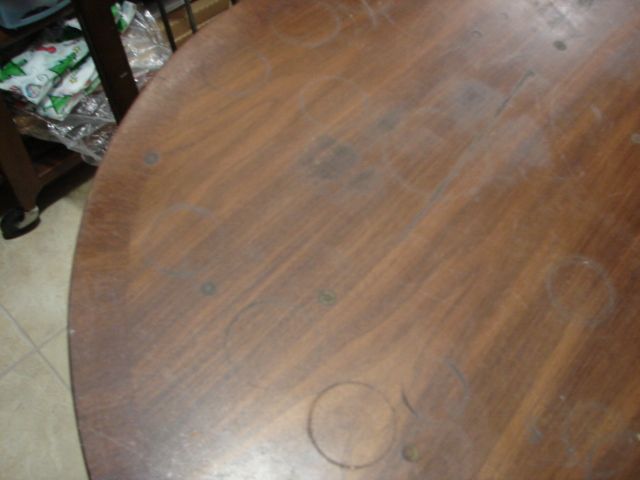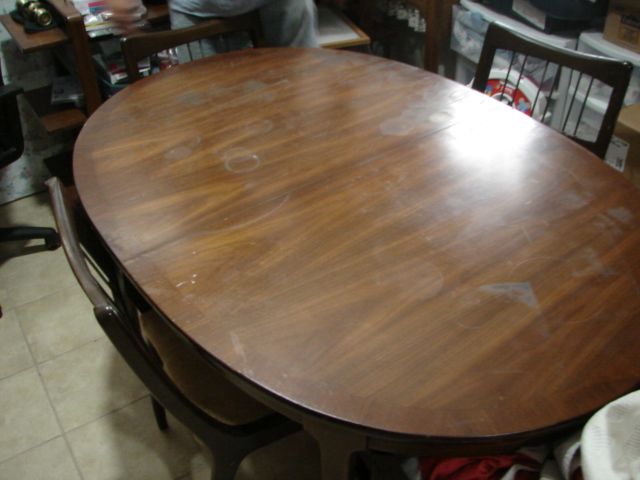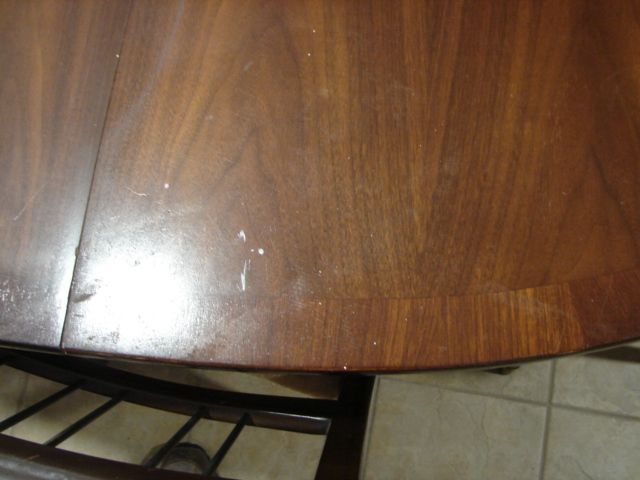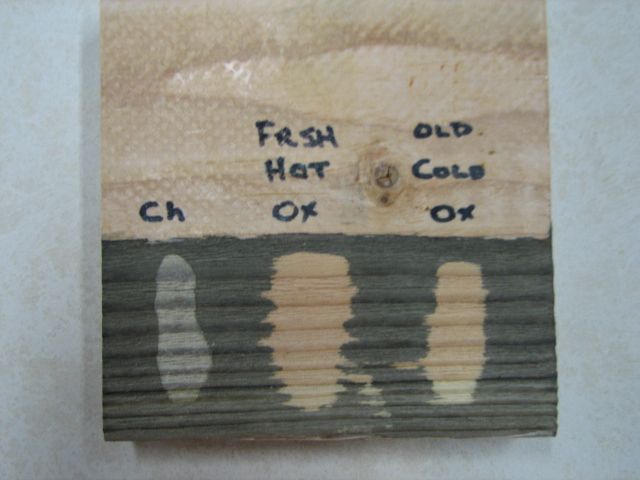Question
I was brought a walnut veneer table to refinish. The original finish was obviously oil, and somewhere in the table's life, someone painted it dark brown. The table has been abused and there were numerous rings on it. The owner wanted the table refinished to the original state, so we stripped the finish off and lightly sanded the top to remove as many imperfections as possible. The table is beautiful, however as soon as we applied boiled linseed oil to the top, the rings came back strong. What step am I missing?
Forum Responses
(Finishing Forum)
From contributor M:
Did you try wetting the top with either lacquer thinner, alcohol, or mineral spirits to see if the rings appear when the wood is wet? If it does, then you are going to have to remove or tone the wood to hide the rings. What coating are you planning to use?

If the black stains do not come out, give the oxalic acid a try. It may take out the stains, but then leave lighter spots in those areas. You may need to bleach again. You can use clean water to soak the wood, which will also neutralize the bleach. Allow to thoroughly dry.
Check the table top. If you're happy with the results, then you may just stain and apply your coating. If you're not happy, then I suggest you make up a translucent tinting toner and go from there.
If you need some help, we will walk you through making up a tinting toner. You may not want to go through all that bleaching. If not, just strip it down again, wash it with lacquer thinners or acetone, sand it, and then stop there, and go with a tinting toner. This thinned out color coating will uniform the wood's color with a combination of pigments and coating in each application.
Contributor M, perhaps I'm missing something, but how did you determine that the table was solid versus a veneer? I think the banding is solid walnut, but how about the surface itself? Looking at the cathedral peaks and how they meet the next flitch, I would have thought the table to be veneer.
To the original questioner: I think you have a diamond in the rough, so proceed with caution and post some pictures of the restoration if you can.
Regarding the veneer vs. solid thoughts, I noticed that some areas, primarily around the banding, have worn through to a substrate. I also noticed that underneath the table, the grain is much different from what is on top. I didn't see any areas where the veneer appeared to be separating from the substrate. Thanks for the advice.

Here is a close-up of the banding on the tabletop.

I suggest that the questioner be very careful trying to sand out those markings, or he will have no choice but to re-veneer the whole top. I think I would rather have him deal with a bad bleaching job than have him sand through the veneer, which is quite easy to do. I might just start with toner over the stripped, cleaned, and lightly sanded table top, and then use the other coloring mediums like a stain, glaze, and a shading stain to add a new matching finish.
In the picture below, the wood (pine) was wire brushed and stained with an iron oxide solution as a sample for a designer who wanted a weathered look. It's the same stain that the questioner faces. On the left, full strength Clorox that was allowed to work for 30 minutes. In the center, a strong solution of fresh, hot, oxalic acid that worked for 3 minutes. On the right, old, cold (but saturated) oxalic solution which worked for 6 minutes. It's hard to tell at this resolution, but the stain is not all gone under the cold solution. If I had let it work longer, it would probably be gone.
I learned this the hard way a long time ago while removing water stains from several bedrooms of oak flooring - the solution didn't work as well when it got old and cold. I also rinsed this job down well with water and when it dried, started sanding. 'Twas then I got this burning sensation in my throat and lungs and learned (again the hard way) it's better to neutralize with a good alkaline solution.
It's as simple as hot water holds more "stuff" in solution and since it's "stuff" that does the job and more is better, hot is good.
Dissolve as much oxalic acid as you can in warm water. Warm water will dissolve more crystals than cold. Use an acid brush or equivalent and put the oa on the dark rings - they appear to be iron stains, which are a result of water being in contact with metal, then contacting the wood, which contains tannin.
Keep rewetting the areas and while doing this, take a rag and wet the entire top with the oa. The oa works when wet. This should take 30 minutes or so. Go back later and do it again, then wait till tomorrow and see what you have. Do not have a draft on the surface while doing this, or it will dry too fast.
You may have to do it again. I do not believe you will have much luck with Clorox (sodium hypochlorite) or with the two part bleach (hydrogen peroxide and sodium hydroxide-lye) in this case, although both have their uses in finishing.
You do not need to neutralize the oa. Just wipe the top with a clean wet rag before resanding or the dust will choke you. This will get it as good as you are going to. Any further blending will have to be done with stains, toners, and such.
From contributor I:
I have worked at high end veneer shops most of my life. Please re-read the part of my post about watching for a color change, which signifies going through the veneer. When you reach the point that you make drastic moves like bleaching a walnut top... I would replace the top over bleaching. Toned out, shaded in walnut doesn't appeal to me.
From contributor R:
From a refinisher's point of view, this table looks pretty typical, from the late 50's, 60's or early 70's. Veneer over plywood, or if it is later, veneer over particleboard, or early MDF if you will. Most of this will come out with the stripping, and if not, then oxalic acid/rinse. When the finishing process is completed, any faint traces of these stains that are left, you can consider character. The transition between before and after is so great your customer will be thrilled. I would look at the long straight edges of the table (where the leaves meet) and determine what's under the veneer - solid wood, plywood, or particle board. If it's particleboard, which it probably isn't, you run the risk of the stripper and water (oxalic acid solution) swelling the particleboard on the edges and where the veneers meet.
From contributor T:
Any progress to report?

Click here for full size image
From the original questioner:
Still working on it. I decided to go this route. I removed the oil/wax finish and then sanded the veneer (definitely veneer) to remove as much of the stain as possible. I'm a novice, but even novices can form opinions (albeit sometimes wrong ones). I decided that what contributor M wrote made a lot of sense to me. I wetted the top with mineral spirits and the rings came back. Not wanting to remove any more wood, I've decided to tone the wood.
From contributor B:
You don't have a difficult problem here. I have done this many times on tables, dressers and such. Strip the table again with a solvent wash stripper. Next wash it with lacquer thinner or acetone, although I like the thinner better as acetone evaporates faster. After it is dry (the following day or at least a couple of hours later), lightly sand the top to make sure you have a clean surface.
From contributor N:
These sorts of rings are a routine occurrence in refinishing, and they can be summed up succinctly: white rings mean that the finish has been affected, and dark rings indicate that the finish has been completely compromised and the wood is now affected. Clearly, the table is veneered; the presence of a crossband is a dead giveaway. The table, although attractive, is by no means a masterpiece worthy of extensive consideration, and sanding out the dark stain is probably in order. I have met with mixed results using bleach, and as another poster has stated, the by-product of the bleaching process tends to linger far past the projectís completion. Sanding, if undertaken judiciously and conscientiously, will easily bring this table back from the brink. Iíve tackled dark heat stains in veneer far more severe than the ones pictured without affecting the timbre (I couldnít resist) of the piece. Bear in mind, however, that the darker the stain, the deeper will be its penetration.
From contributor B:
This should not be a problem to restore! Re-strip using a good stripper; not a water wash, but a solvent wash. Then wash it with lacquer thinner. Lightly sand the top with 180. Then, and most important, get some oxalic acid, dissolve as much as you can in some warm water; use glass, not metal. Put the acid on the dark spots only to start, use a small acid brush like we use for glue application. Get the spots wet. Keep dabbing it on for 5-15 minutes. At some point, wipe the whole top with a rag wetted with the acid, then reapply the acid to the spots. You may have to do this for a day or two. The last step is to rewet the entire top with the wetted acid rag. The spots will go away. After a couple of days and the table is dry, clean it off with water only - no need to do any type of soda wash or anything else but water and a rag. If you do not clean off with water, the dust from sanding will take your breath away, but it will not affect the finish. Clean it with water anyway. While the top is wet with water, that is what it will look like when you put coating on it. Wetting is your test to see if the wood is clear of spots and rings. Have fun and charge accordingly!